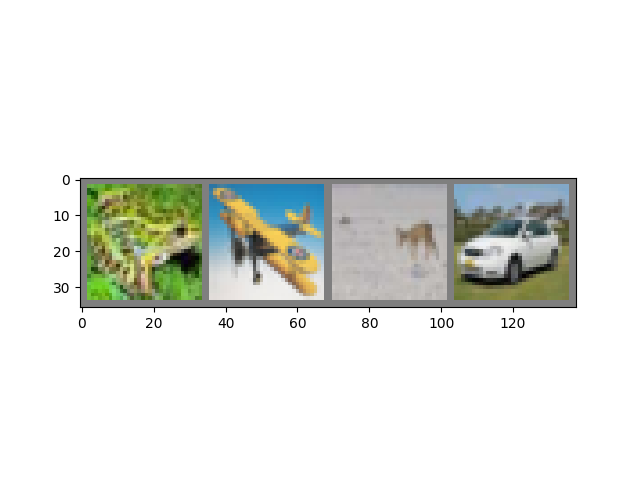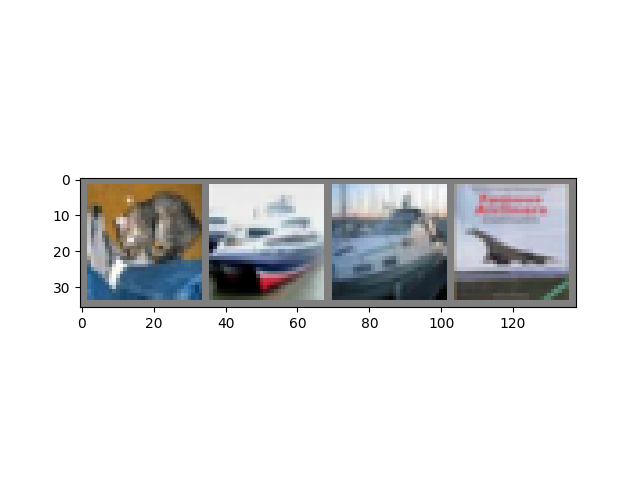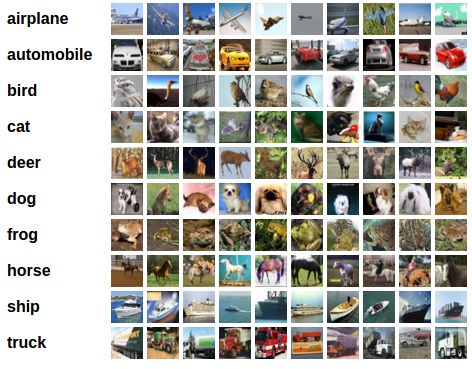Note
Click here to download the full example code
Training a Classifier
Created On: Mar 24, 2017 | Last Updated: Dec 20, 2024 | Last Verified: Not Verified
This is it. You have seen how to define neural networks, compute loss and make updates to the weights of the network.
Now you might be thinking,
What about data?
Generally, when you have to deal with image, text, audio or video data,
you can use standard python packages that load data into a numpy array.
Then you can convert this array into a torch.*Tensor.
For images, packages such as Pillow, OpenCV are useful
For audio, packages such as scipy and librosa
For text, either raw Python or Cython based loading, or NLTK and SpaCy are useful
Specifically for vision, we have created a package called
torchvision, that has data loaders for common datasets such as
ImageNet, CIFAR10, MNIST, etc. and data transformers for images, viz.,
torchvision.datasets and torch.utils.data.DataLoader.
This provides a huge convenience and avoids writing boilerplate code.
For this tutorial, we will use the CIFAR10 dataset. It has the classes: ‘airplane’, ‘automobile’, ‘bird’, ‘cat’, ‘deer’, ‘dog’, ‘frog’, ‘horse’, ‘ship’, ‘truck’. The images in CIFAR-10 are of size 3x32x32, i.e. 3-channel color images of 32x32 pixels in size.
Training an image classifier
We will do the following steps in order:
Load and normalize the CIFAR10 training and test datasets using
torchvisionDefine a Convolutional Neural Network
Define a loss function
Train the network on the training data
Test the network on the test data
1. Load and normalize CIFAR10
Using torchvision, it’s extremely easy to load CIFAR10.
import torch
import torchvision
import torchvision.transforms as transforms
The output of torchvision datasets are PILImage images of range [0, 1]. We transform them to Tensors of normalized range [-1, 1].
Note
If running on Windows and you get a BrokenPipeError, try setting the num_worker of torch.utils.data.DataLoader() to 0.
transform = transforms.Compose(
[transforms.ToTensor(),
transforms.Normalize((0.5, 0.5, 0.5), (0.5, 0.5, 0.5))])
batch_size = 4
trainset = torchvision.datasets.CIFAR10(root='./data', train=True,
download=True, transform=transform)
trainloader = torch.utils.data.DataLoader(trainset, batch_size=batch_size,
shuffle=True, num_workers=2)
testset = torchvision.datasets.CIFAR10(root='./data', train=False,
download=True, transform=transform)
testloader = torch.utils.data.DataLoader(testset, batch_size=batch_size,
shuffle=False, num_workers=2)
classes = ('plane', 'car', 'bird', 'cat',
'deer', 'dog', 'frog', 'horse', 'ship', 'truck')
0%| | 0.00/170M [00:00<?, ?B/s]
0%| | 459k/170M [00:00<00:37, 4.55MB/s]
4%|4 | 7.57M/170M [00:00<00:03, 43.5MB/s]
10%|9 | 16.9M/170M [00:00<00:02, 66.2MB/s]
15%|#5 | 26.0M/170M [00:00<00:01, 76.0MB/s]
21%|##1 | 36.5M/170M [00:00<00:01, 86.2MB/s]
27%|##6 | 45.8M/170M [00:00<00:01, 88.5MB/s]
32%|###2 | 55.2M/170M [00:00<00:01, 90.3MB/s]
38%|###8 | 65.4M/170M [00:00<00:01, 94.0MB/s]
44%|####3 | 74.8M/170M [00:00<00:01, 93.6MB/s]
49%|####9 | 84.3M/170M [00:01<00:00, 94.2MB/s]
56%|#####5 | 94.7M/170M [00:01<00:00, 97.1MB/s]
61%|######1 | 104M/170M [00:01<00:00, 94.9MB/s]
67%|######6 | 114M/170M [00:01<00:00, 94.9MB/s]
73%|#######3 | 125M/170M [00:01<00:00, 98.9MB/s]
79%|#######9 | 135M/170M [00:01<00:00, 95.7MB/s]
85%|########4 | 144M/170M [00:01<00:00, 93.6MB/s]
91%|#########1| 156M/170M [00:01<00:00, 99.6MB/s]
97%|#########7| 166M/170M [00:01<00:00, 96.7MB/s]
100%|##########| 170M/170M [00:01<00:00, 90.5MB/s]
Let us show some of the training images, for fun.
import matplotlib.pyplot as plt
import numpy as np
# functions to show an image
def imshow(img):
img = img / 2 + 0.5 # unnormalize
npimg = img.numpy()
plt.imshow(np.transpose(npimg, (1, 2, 0)))
plt.show()
# get some random training images
dataiter = iter(trainloader)
images, labels = next(dataiter)
# show images
imshow(torchvision.utils.make_grid(images))
# print labels
print(' '.join(f'{classes[labels[j]]:5s}' for j in range(batch_size)))

frog plane deer car
2. Define a Convolutional Neural Network
Copy the neural network from the Neural Networks section before and modify it to take 3-channel images (instead of 1-channel images as it was defined).
import torch.nn as nn
import torch.nn.functional as F
class Net(nn.Module):
def __init__(self):
super().__init__()
self.conv1 = nn.Conv2d(3, 6, 5)
self.pool = nn.MaxPool2d(2, 2)
self.conv2 = nn.Conv2d(6, 16, 5)
self.fc1 = nn.Linear(16 * 5 * 5, 120)
self.fc2 = nn.Linear(120, 84)
self.fc3 = nn.Linear(84, 10)
def forward(self, x):
x = self.pool(F.relu(self.conv1(x)))
x = self.pool(F.relu(self.conv2(x)))
x = torch.flatten(x, 1) # flatten all dimensions except batch
x = F.relu(self.fc1(x))
x = F.relu(self.fc2(x))
x = self.fc3(x)
return x
net = Net()
3. Define a Loss function and optimizer
Let’s use a Classification Cross-Entropy loss and SGD with momentum.
import torch.optim as optim
criterion = nn.CrossEntropyLoss()
optimizer = optim.SGD(net.parameters(), lr=0.001, momentum=0.9)
4. Train the network
This is when things start to get interesting. We simply have to loop over our data iterator, and feed the inputs to the network and optimize.
for epoch in range(2): # loop over the dataset multiple times
running_loss = 0.0
for i, data in enumerate(trainloader, 0):
# get the inputs; data is a list of [inputs, labels]
inputs, labels = data
# zero the parameter gradients
optimizer.zero_grad()
# forward + backward + optimize
outputs = net(inputs)
loss = criterion(outputs, labels)
loss.backward()
optimizer.step()
# print statistics
running_loss += loss.item()
if i % 2000 == 1999: # print every 2000 mini-batches
print(f'[{epoch + 1}, {i + 1:5d}] loss: {running_loss / 2000:.3f}')
running_loss = 0.0
print('Finished Training')
[1, 2000] loss: 2.143
[1, 4000] loss: 1.833
[1, 6000] loss: 1.674
[1, 8000] loss: 1.574
[1, 10000] loss: 1.524
[1, 12000] loss: 1.445
[2, 2000] loss: 1.405
[2, 4000] loss: 1.363
[2, 6000] loss: 1.339
[2, 8000] loss: 1.342
[2, 10000] loss: 1.311
[2, 12000] loss: 1.274
Finished Training
Let’s quickly save our trained model:
PATH = './cifar_net.pth'
torch.save(net.state_dict(), PATH)
See here for more details on saving PyTorch models.
5. Test the network on the test data
We have trained the network for 2 passes over the training dataset. But we need to check if the network has learnt anything at all.
We will check this by predicting the class label that the neural network outputs, and checking it against the ground-truth. If the prediction is correct, we add the sample to the list of correct predictions.
Okay, first step. Let us display an image from the test set to get familiar.
dataiter = iter(testloader)
images, labels = next(dataiter)
# print images
imshow(torchvision.utils.make_grid(images))
print('GroundTruth: ', ' '.join(f'{classes[labels[j]]:5s}' for j in range(4)))

GroundTruth: cat ship ship plane
Next, let’s load back in our saved model (note: saving and re-loading the model wasn’t necessary here, we only did it to illustrate how to do so):
net = Net()
net.load_state_dict(torch.load(PATH, weights_only=True))
<All keys matched successfully>
Okay, now let us see what the neural network thinks these examples above are:
The outputs are energies for the 10 classes. The higher the energy for a class, the more the network thinks that the image is of the particular class. So, let’s get the index of the highest energy:
Predicted: frog ship ship plane
The results seem pretty good.
Let us look at how the network performs on the whole dataset.
correct = 0
total = 0
# since we're not training, we don't need to calculate the gradients for our outputs
with torch.no_grad():
for data in testloader:
images, labels = data
# calculate outputs by running images through the network
outputs = net(images)
# the class with the highest energy is what we choose as prediction
_, predicted = torch.max(outputs, 1)
total += labels.size(0)
correct += (predicted == labels).sum().item()
print(f'Accuracy of the network on the 10000 test images: {100 * correct // total} %')
Accuracy of the network on the 10000 test images: 55 %
That looks way better than chance, which is 10% accuracy (randomly picking a class out of 10 classes). Seems like the network learnt something.
Hmmm, what are the classes that performed well, and the classes that did not perform well:
# prepare to count predictions for each class
correct_pred = {classname: 0 for classname in classes}
total_pred = {classname: 0 for classname in classes}
# again no gradients needed
with torch.no_grad():
for data in testloader:
images, labels = data
outputs = net(images)
_, predictions = torch.max(outputs, 1)
# collect the correct predictions for each class
for label, prediction in zip(labels, predictions):
if label == prediction:
correct_pred[classes[label]] += 1
total_pred[classes[label]] += 1
# print accuracy for each class
for classname, correct_count in correct_pred.items():
accuracy = 100 * float(correct_count) / total_pred[classname]
print(f'Accuracy for class: {classname:5s} is {accuracy:.1f} %')
Accuracy for class: plane is 43.5 %
Accuracy for class: car is 67.2 %
Accuracy for class: bird is 44.7 %
Accuracy for class: cat is 29.5 %
Accuracy for class: deer is 48.9 %
Accuracy for class: dog is 47.0 %
Accuracy for class: frog is 60.5 %
Accuracy for class: horse is 70.9 %
Accuracy for class: ship is 79.8 %
Accuracy for class: truck is 65.4 %
Okay, so what next?
How do we run these neural networks on the GPU?
Training on GPU
Just like how you transfer a Tensor onto the GPU, you transfer the neural net onto the GPU.
Let’s first define our device as the first visible cuda device if we have CUDA available:
device = torch.device('cuda:0' if torch.cuda.is_available() else 'cpu')
# Assuming that we are on a CUDA machine, this should print a CUDA device:
print(device)
cuda:0
The rest of this section assumes that device is a CUDA device.
Then these methods will recursively go over all modules and convert their parameters and buffers to CUDA tensors:
net.to(device)
Remember that you will have to send the inputs and targets at every step to the GPU too:
Why don’t I notice MASSIVE speedup compared to CPU? Because your network is really small.
Exercise: Try increasing the width of your network (argument 2 of
the first nn.Conv2d, and argument 1 of the second nn.Conv2d –
they need to be the same number), see what kind of speedup you get.
Goals achieved:
Understanding PyTorch’s Tensor library and neural networks at a high level.
Train a small neural network to classify images
Training on multiple GPUs
If you want to see even more MASSIVE speedup using all of your GPUs, please check out Optional: Data Parallelism.
Where do I go next?
Train a face generator using Generative Adversarial Networks
Train a word-level language model using Recurrent LSTM networks
del dataiter
Total running time of the script: ( 1 minutes 26.732 seconds)




